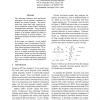Free Online Productivity Tools
i2Speak
i2Symbol
i2OCR
iTex2Img
iWeb2Print
iWeb2Shot
i2Type
iPdf2Split
iPdf2Merge
i2Bopomofo
i2Arabic
i2Style
i2Image
i2PDF
iLatex2Rtf
Sci2ools
EMNLP
2009
2009
Synchronous Tree Adjoining Machine Translation
Tree Adjoining Grammars have well-known advantages, but are typically considered too difficult for practical systems. We demonstrate that, when done right, adjoining improves translation quality without becoming computationally intractable. Using adjoining to model optionality allows general translation patterns to be learned without the clutter of endless variations of optional material. The appropriate modifiers can later be spliced in as needed. In this paper, we describe a novel method for learning a type of Synchronous Tree Adjoining Grammar and associated probabilities from aligned tree/string training data. We introduce a method of converting these grammars to a weakly equivalent tree transducer for decoding. Finally, we show that adjoining results in an end-to-end improvement of +0.8 BLEU over a baseline statistical syntax-based MT model on a large-scale Arabic/English MT task.
EMNLP 2009 | Natural Language Processing | Statistical Syntax-based Mt | Tree Adjoining Grammar | Weakly Equivalent Tree |
Related Content
| Added | 17 Feb 2011 |
| Updated | 17 Feb 2011 |
| Type | Journal |
| Year | 2009 |
| Where | EMNLP |
| Authors | Steve DeNeefe, Kevin Knight |
Comments (0)

